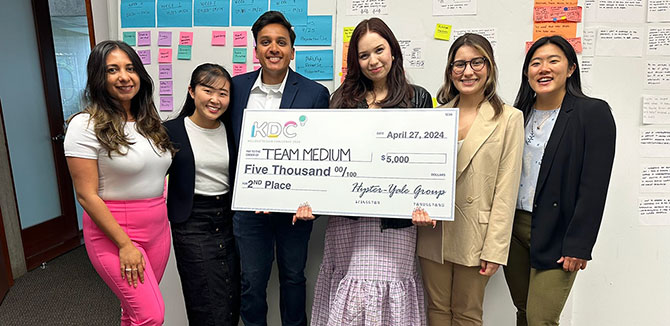A Unique MMM, EDI Collaboration
Students from Northwestern's MBA + MS in Design Innovation (MMM) and Engineering Design Innovation programs partnered to finish second in the Kellogg Design Challenge.

Samir Ramakrishnan (MMM '25) wanted to apply his creative problem solving skills in an unfamiliar area.
He found it in a novel way.
Ramakrishnan partnered with a classmate from Northwestern's MBA + MS in Design Innovation (MMM) program, three students from Northwestern's Master of Science in Engineering Design Innovation (EDI) program, and one student from the Kellogg School of Management's Two-Year MBA program to compete in the 2024 Kellogg Design Challenge (KDC).
It was the first time students from MMM and EDI collaborated in KDC, the largest business design case competition across MBA programs in the world.
The six students — known as Team Medium — took second place and won $5,000 in the competition.
"It felt extremely rewarding," Sam Lee (MMM '25) said. "We all put a lot of time into this project, so we were glad to see it pay off. Perhaps even more rewarding was knowing that our team, consisting of folks with very different backgrounds, was able to come together to deliver such a solid proposal."
The theme for the competition was "AI x Design."
Team Medium was tasked with designing a solution for Hyster-Yale Group that integrated artificial intelligence (AI) to help speed up product development processes across business units. To do that, the team relied on human-centered design skills Lee and Ramakrishnan developed in MMM — specifically in the program's foundational Research Design Build (RDB) course.
"From our learnings in RDB, we conducted effective primary research with a variety of relevant candidates and utilized different frameworks to better ideate through potential options," Ramakrishnan said. "RDB provided us with the tools to answer the KDC prompt in an effective manner."
Team Medium identified that constant cross-functional coordination between company groups led to tense meetings and push back resulting from conflicting priorities. Those conflicts stifled creative processes and led to group-aligned solutions — but did not satisfy user needs.
To fix that, Team Medium developed "advAIce." The tool provided an AI-based portal that gave teams immediate feedback from the perspective of the other teams they needed to coordinate with.
"This portal could review documents and, with the feedback it provides, allow teams to validate their assumptions and identify key issues before scheduling meetings," Ramakrishnan said. "In addition, the feedback can ensure the user’s perspective is always being considered on every iteration of the product design."
Lee was proud their solution kept the users top of mind — a hallmark of the human-centered design framework taught in both MMM and EDI.
"I thought our solution uniquely focused on the humans involved in the product development process by acknowledging that the existing process can cause frustration when it doesn’t feel like everyone is being heard," she said. "Our solution was designed to address this underlying issue."
KDC allowed Ramakrishnan and Lee to apply their creative problem solving skills in a unique way. It also showed them the power of diverse teams and using each member's strengths to help the group.
"Our EDI teammates were invaluable to us as they brought the visualization tools and creative design skills that meshed perfectly with our human-centered design mindset," Ramakrishnan said. "When we were able to combine efforts, this led to a product that was not only well thought out but was presented in a very effective manner."
